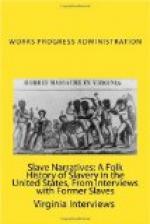“He came by slowly covering corn but the negro did not shoot. Williams said, “Why didn’t you shoot?” and the negro replied, “Massie, I just didn’t have da heart.” Williams said, “If you don’t shoot next time, I’m going to shoot you.” When Stevens started by the negro shot and killed him, tearing his hoe handle into splinters.
One day a salesman, who rode a fine horse and had a beautiful saddle came to Princeton and later went to the Williams home. Several days later his people got anxious about him, and after checking up they found that he was last seen going into the Williams home. Several days later his people found his hat floating upon a pond near the house, and a few weeks later one of the Williams boys came to town riding the saddle that the salesman had ridden a few months before.
The old negro slave went to Mr. Stevens to visit his wife, and while he and Mr. Stevens were in the field a spy was hidden in the ambush listening to the conversation about the salesman. When the old slave returned home he was tied to the tail of a young mule, which was turned loose in a new ground and was dragged, bruised and almost killed. Edward Williams, son of Jess Williams, found the old slave and cut him loose. His father and brother found it out and started out to hunt him, intending to kill him, but he managed to dodge them.
Mr. Jess Stevens was walking along a path the next morning and heard a mournful groan, and after looking for awhile found the old slave. The worms had eaten his face[HW:?] and he was almost dead. The people brought him to the courthouse and began ringing the bell to let the people know that some injustice had been done. When one became tired another took his place. The bell rang both night and day until most of the citizens of the county came to see what was wrong. A number of men went in daytime, without mask or disguise, to the Williams home and hung Jess Williams. They intended to hang the two boys but they got away.
Ballard Co.
(J.R. Wilkerson) [HW: Ky 7]
[Tinie Force and Elvira Lewis:]
During the period of slavery in the Purchase Region, buying and selling slaves was carried on at irregular intervals. The trading usually took place at the home of the slave owner. The prices paid for slaves was dependent upon certain conditions. In case of a full grown, robust negro boy the price was sometimes as much as one thousand dollars. The prices paid was varied according to the age, the general health and other conditions of the individual.
At times pathetic scenes prevailed in the selling of slaves; namely, the separation of mother and child. Often, a boy or girl would be sold and taken away from his or her mother. In many cases the parting would be permanent and the child and its mother would never see each other again.
The slave owner maintained separate housing quarters for his slaves. In some cases the living quarters of slaves was comfortable and agreeable; in other cases, living conditions of slaves was anything but agreeable; Some masters were reasonably gentle to their slaves, while others were cruel.




